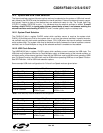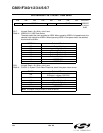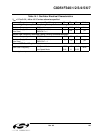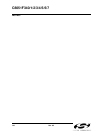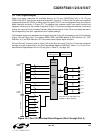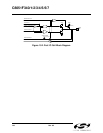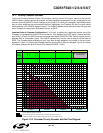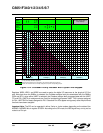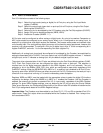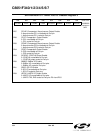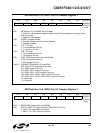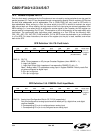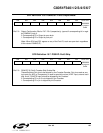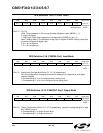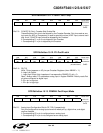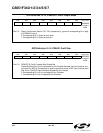
Rev. 0.5 151
C8051F340/1/2/3/4/5/6/7
15.2. Port I/O Initialization
Port I/O initialization consists of the following steps:
Step 1. Select the input mode (analog or digital) for all Port pins, using the Port Input Mode
register (PnMDIN).
Step 2. Select the output mode (open-drain or push-pull) for all Port pins, using the Port Output
Mode register (PnMDOUT).
Step 3. Select any pins to be skipped by the I/O Crossbar using the Port Skip registers (PnSKIP).
Step 4. Assign Port pins to desired peripherals (XBR0, XBR1).
Step 5. Enable the Crossbar (XBARE = ‘1’).
All Port pins must be configured as either analog or digital inputs. Any pins to be used as Comparator or
ADC inputs should be configured as an analog inputs. When a pin is configured as an analog input, its
weak pull-up, digital driver, and digital receiver are disabled. This process saves power and reduces noise
on the analog input. Pins configured as digital inputs may still be used by analog peripherals; however this
practice is not recommended. To configure a Port pin for digital input, write ‘0’ to the corresponding bit in
register PnMDOUT, and write ‘1’ to the corresponding Port latch (register Pn).
Additionally, all analog input pins should be configured to be skipped by the Crossbar (accomplished by
setting the associated bits in PnSKIP). Port input mode is set in the PnMDIN register, where a ‘1’ indicates
a digital input, and a ‘0’ indicates an analog input. All pins default to digital inputs on reset.
The output driver characteristics of the I/O pins are defined using the Port Output Mode registers (PnMD-
OUT). Each Port Output driver can be configured as either open drain or push-pull. This selection is
required even for the digital resources selected in the XBRn registers, and is not automatic. The only
exception to this is the SMBus (SDA, SCL) pins, which are configured as open-drain regardless of the
PnMDOUT settings. When the WEAKPUD bit in XBR1 is ‘0’, a weak pull-up is enabled for all Port I/O con
-
figured as open-drain. WEAKPUD does not affect the push-pull Port I/O. Furthermore, the weak pull-up is
turned off on an output that is driving a ‘0’ to avoid unnecessary power dissipation.
Registers XBR0 and XBR1 must be loaded with the appropriate values to select the digital I/O functions
required by the design. Setting the XBARE bit in XBR1 to ‘1’ enables the Crossbar. Until the Crossbar is
enabled, the external pins remain as standard Port I/O (in input mode), regardless of the XBRn Register
settings. For given XBRn Register settings, one can determine the I/O pin-out using the Priority Decode
Table; as an alternative, the Configuration Wizard utility of the Silicon Labs IDE software will determine the
Port I/O pin-assignments based on the XBRn Register settings.
Important Note: The Crossbar must be enabled to use Ports P0, P1, P2, and P3 as standard Port I/O in
output mode. These Port output drivers are disabled while the Crossbar is disabled. Port 4 always func
-
tions as standard GPIO.



